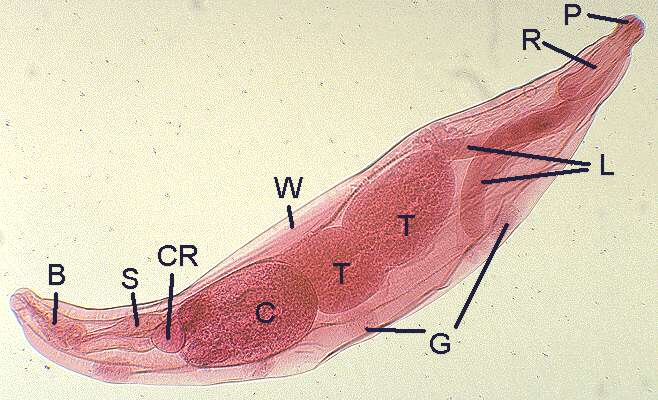
Acanthocephala are pseudocoelomate animals with two major body regions. One region, at the anterior end of the body, is a retractable proboscis (P). The second region, posteriorly, is the trunk, or soma. The trunk is the main body and is generally cylindrical in shape, although in some species the trunk is expanded markedly in the anterior region. The body wall (W) of some species contains distinctive giant nuclei (G). Sexes are separate. Male and female gonads generally float within the body cavity, and the genital pores of both sexes are at the posterior terminus of the body.
The proboscis is covered with hooks, and is attached to the trunk by a neck. These hooks have a characteristic shape, number and arrangement for each species, and enable the worm to attach securely to the intestine of its host. The proboscis retracts into a proboscis sheath (= receptacle) (R). There are muscles inside the proboscis sheath that attach internally to the tip of the proboscis, and also muscles on the outside of the proboscis sheath that attach it to the internal wall of the trunk.
The trunk is covered externally by a syncytial tegument, and internally is crisscrossed by a ladder-like arrangement of fluid-filled channels, the lacunar system. The lacunae, which are easily seen, may act as a transport system. The lacunae are also connected to a pair of internal appendages, the lemnisci (L), which arise near the point where the proboscis sheath attaches to the trunk, and float free within the body cavity. Acanthocephalans do not possess a mouth or digestive tract; all nutrients are absorbed as in cestodes.
The male reproductive system is contained within one or two ligament sacs, which may break down early in development. There are two testes (T) arranged in tandem. Spermatozoa are carried by vasa efferentia to a common vas deferens and collect in a seminal vesicle (S). The seminal vesicle is connected to an eversible copulatory bursa (B). A fluid-filled Saefftigen's pouch is connected to the bursa and is used to evert the bursa. There are one or more cement glands (C) whose products collect in a cement reservoir (CR), and then pass to the copulatory bursa. The cement is used to seal the vagina of the female after copulation.

The female reproductive system is contained within one or two ligament sacs, which may break down early in development. The ovary soon fragments into a large number of ovarian balls (OB), each comprising a small number of oocytes. After fertilization of the oocytes, embryonic development and egg shell formation commences. When egg shell formation nears completion, the egg breaks free of the ovarian ball and floats freely within the body cavity, completing its maturation. At the posterior end of the body cavity is a uterine bell (UB) and selector apparatus (S). Eggs within the body cavity are constantly flowing through the uterine bell and into the selector apparatus. Immature eggs are returned to the body cavity, but mature eggs are channeled into a uterus (U), which connects via a short vagina to a vulva (V). Occasionally a cement cap will be seen over the vulva, deposited by the male after copulation.

The egg consists of several layers of membranes enclosing an embryo. The egg may be oval in outline or have some form of polar elongations. The surface may be smooth or sculptured. Eggs are embryonated when deposited, and contain an acanthor.
The acanthor is relatively undifferentiated, but possess a number of blade-like hooks at one end which are used to aid in penetration of the gut of its arthropod intermediate host.
The acanthella, which develops from the acanthor in the haemocoele of the arthropod, develops most of the structures of the adult worm.

The cystacanth is the terminal larval developmental stage. It has all the structures of the adult, including reproductive system, and is infective to the definitive host. In most species, the proboscis invaginates and a hyaline cyst is secreted around it.